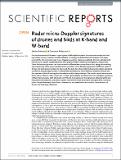Files in this item
Radar micro-Doppler signatures of drones and birds at K-band and W-band
Item metadata
| dc.contributor.author | Rahman, Samiur | |
| dc.contributor.author | Robertson, Duncan Alexander | |
| dc.date.accessioned | 2018-11-29T13:30:05Z | |
| dc.date.available | 2018-11-29T13:30:05Z | |
| dc.date.issued | 2018-11-26 | |
| dc.identifier | 256565966 | |
| dc.identifier | 40d0e2c3-ded7-40d7-b094-62abe6cfda0c | |
| dc.identifier | 85057280387 | |
| dc.identifier | 000451184500001 | |
| dc.identifier.citation | Rahman , S & Robertson , D A 2018 , ' Radar micro-Doppler signatures of drones and birds at K-band and W-band ' , Scientific Reports , vol. 8 , 17396 . https://doi.org/10.1038/s41598-018-35880-9 | en |
| dc.identifier.issn | 2045-2322 | |
| dc.identifier.other | ORCID: /0000-0002-4042-2772/work/51261023 | |
| dc.identifier.other | ORCID: /0000-0002-5477-4218/work/51261125 | |
| dc.identifier.uri | https://hdl.handle.net/10023/16577 | |
| dc.description | The authors acknowledge the funding received from the Science and Technology Facilities Council which has supported this work under grant ST/N006569/1 | en |
| dc.description.abstract | Due to the substantial increase in the number of affordable drones in the consumer market and their regrettable misuse, there is a need for efficient technology to detect drones in airspace. This paper presents the characteristic radar micro-Doppler properties of drones and birds. Drones and birds both induce micro-Doppler signatures due to their propeller blade rotation and wingbeats, respectively. These distinctive signatures can then be used to differentiate a drone from a bird, along with studying them separately. Here, experimental measurements of micro-Doppler signatures of different types of drones and birds are presented and discussed. The data have been collected using two radars operating at different frequencies; K-band (24 GHz) and W-band (94 GHz). Three different models of drones and four species of birds of varying sizes have been used for data collection. The results clearly demonstrate that a phase coherent radar system can retrieve highly reliable and distinctive micro-Doppler signatures of these flying targets, both at K-band and W-band. Comparison of the signatures obtained at the two frequencies indicates that the micro-Doppler return from the W-band radar has higher SNR. However, micro-Doppler features in the K-band radar returns also reveal the micro-motion characteristics of drones and birds very effectively. | |
| dc.format.extent | 11 | |
| dc.format.extent | 2966940 | |
| dc.language.iso | eng | |
| dc.relation.ispartof | Scientific Reports | en |
| dc.subject | QC Physics | en |
| dc.subject | QH301 Biology | en |
| dc.subject | TK Electrical engineering. Electronics Nuclear engineering | en |
| dc.subject | NDAS | en |
| dc.subject | BDC | en |
| dc.subject | R2C | en |
| dc.subject.lcc | QC | en |
| dc.subject.lcc | QH301 | en |
| dc.subject.lcc | TK | en |
| dc.title | Radar micro-Doppler signatures of drones and birds at K-band and W-band | en |
| dc.type | Journal article | en |
| dc.contributor.sponsor | Science & Technology Facilities Council | en |
| dc.contributor.institution | University of St Andrews. School of Physics and Astronomy | en |
| dc.identifier.doi | https://doi.org/10.1038/s41598-018-35880-9 | |
| dc.description.status | Peer reviewed | en |
| dc.identifier.grantnumber | ST/N006569/1 | en |
This item appears in the following Collection(s)
Items in the St Andrews Research Repository are protected by copyright, with all rights reserved, unless otherwise indicated.

